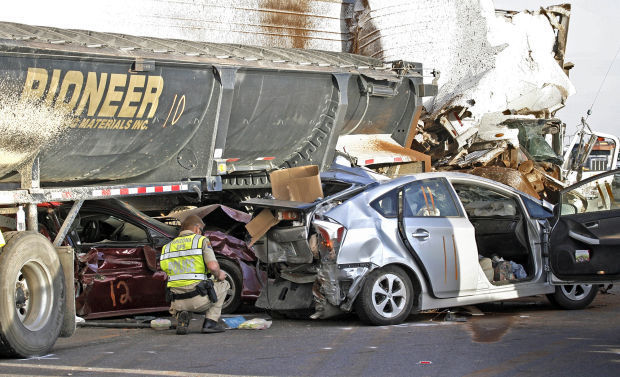COOLIDGE — The problem of blowing dust along the interstate will worsen in coming years, but detection and warning about the deadly threat is improving, experts at the 2016 Arizona Dust Storm Workshop said Monday.
The problem is huge, said Arizona State University researcher Peter Hyde. Blowing dust in Central Arizona, including the dust that causes fatal crashes on Interstate 10, comes primarily from 350,000 acres of fallowed farmland, mostly in Pinal and Maricopa counties, he said.
“It is likely to increase with a hotter, drier climate and with reduced delivery of Central Arizona Project water and additional restrictions on groundwater pumping,” said Hyde, a visiting professor with ASU’s Environmental Fluid Dynamics Program.
Restoration of dusty plots of land downwind of the interstate is needed, said Sen. Steve Farley, D-Tucson.
Farley said he was caught in a dust-caused traffic pileup on Oct. 29, 2013, that came on so quickly “there was no way signage or warnings would have helped.” Three people died that day in a series of crashes.
“What you’re doing here is saving lives” he told the group of weather forecasters, transportation planners and academic researchers convened for the fifth straight year by the Phoenix and Tucson offices of the National Weather Service and the Arizona Department of Transportation.
This year’s group included researchers and officials from Nevada, New Mexico, Texas and the state of Chihuahua in Mexico.
Farley said he is working with federal soil conservationists to address the specific problem at his crash site, near some long-abandoned farmland between mileposts 212 and 214.
He said a nearby 1979 project by the Natural Resources Conservation Service was successful in revegetating a small strip of land along I-10 and could be re-created at the crash site.
Steve Smarik, Arizona resource conservationist for the weather service, said he thinks the 1979 test, which bulldozed berms and planted vegetation, successfully reduced blowing dust on the plot, but he has no data to show how much it helped.
Smarik said the big hurdle is funding. Mitigating the dust problem in the West would require “an army of conservationists” akin to the Depression-era Civilian Conservation Corps, he said. It would be cheaper to build a 10-foot-high wall along the interstates in places where dust-caused accidents occur, he said. He joked that you would probably have to remove the sand dunes yearly.
“We need to disabuse ourselves of this notion that there is going to be easy mitigation or one answer,” said University of Arizona researcher Kyle Rine, who has begun deploying a portable wind tunnel he built to measure dust coming off mine tailings to an I-10 “hot spot” near Picacho Peak.
Dust storms come in three basic varieties, researchers said. The large-scale events that blow dust from state to state, and even across continents, are not seen in Arizona.
The center of the state does get hit with towering haboobs caused by outflow winds associated with thunderstorms, Ken Waters, meteorologist with the National Weather Service in Phoenix, said. You can see those coming, he said, on radar and on the ground. They usually don’t reduce visibility enough to cause wrecks.
The killer storms are the “narrow, low-lying dust channel events” that pop up quickly and fly under the radar.
Waters has developed a low-cost sensor to see the storms that the weather service cannot and deployed nine of them in areas identified as deadly by analyzing Arizona crash data.
The sensor network made its first identification on Jan. 13 near Red Rock just north of Tucson, and the National Weather Service sent out an alert, he said.
The weather service has issued more alerts about blowing dust in recent years, and the Arizona Department of Transportation has studied and improved its advice to drivers.
Glenn Lader, of the National Weather Service office in Tucson, urged the group to focus on what can be done about mitigation of dust sources near the interstate, rather than the immensity of the problem.
“Let’s tackle the hot spots,” he said.





